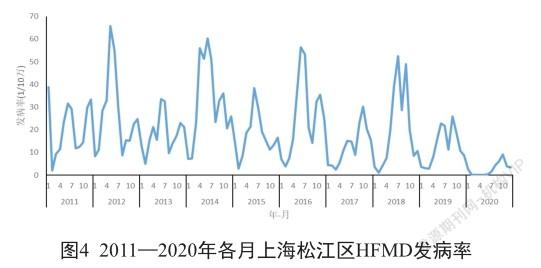2011-2020年上海松江區手足口病的流行病學特征和時空聚集
錢燕琴 馬紀林



摘 要 目的:描述手足口病(Hand,foot and mouth disease,HFMD)在上海松江區各街道/鎮層面的流行病學與時空之間的分布特征。方法:從國家疾病監測系統中收集2011-2020年HFMD監測報告的數據來分析統計HFMD流行病集群和時空分布。結果:2011-2020年上海松江區HFMD的年均發病率為211.13/10萬,92.60%的HFMD病例發病年齡在0~6歲之間,患者中男性占60.08%。HFMD的季節性高峰期在5-10月。HFMD的發病在街道/鎮之間的分布是不均勻的,10年間有5個街道/鎮發病率高于全區平均水平。HFMD病例主要集中在城鄉邊緣地區與人口稠密地區。結論:每年5月至10月,上海松江區城鄉邊緣地區與人口稠密地區是HFMD的高發地區;學齡前兒童是重點防治人群。提示上海松江區HFMD的防控工作應重點關注這些高危時段、高發地區和重點人群,注意公共衛生資源的配置。
關鍵詞 手足口病;發病率;時空聚集
中圖分類號:R512.6 文獻標志碼:A 文章編號:1006-1533(2021)20-0046-04
Epidemiological characteristics and temporal and spatial aggregation of hand, foot and mouth disease in Songjiang, Shanghai from 2011 to 2020
QIAN Yanqin, MA Jilin(Prevention and Health Care Department of Sijing Community Health Service Center of Songjiang District, Shanghai 201601, China)
ABSTRACT Objective: To describe the distribution characteristics between epidemiology and time and space of hand, foot and mouth disease(HFMD) at the sub district/town levels in Songjiang District, Shanghai. Methods: HFMD surveillance and reporting data were collected from the national disease surveillance system for the period 2011-2020 to analyse statistical HFMD epidemic clusters and temporal and spatial distribution. Results: From 2011 to 2020, the average annual incidence of HFMD cases in Songjiang District was 211.13/100 000, 92.60% of HFMD cases occurred between 0 and 6 years old, and men accounted for 60.08%. The seasonal peak was between May and October. The incidence of HFMD was unevenly distributed among sub districts/towns, and the incidence rate of 5 sub districts/towns was higher than that of the whole district in 10 years. HFMD cases were mainly concentrated in the rural and urban fringe areas and in densely populated areas. Conclusion: The main locations of HFMD are the rural and urban fringe areas and the densely populated areas of Songjiang District, Shanghai between May and October; preschool children are the key population for prevention and treatment. It is suggested that the prevention and control of HFMD in Songjiang District of Shanghai should focus on these high-risk periods, high-risk areas and key groups, and pay attention to the allocation of public health resources.
KEY WORDS hand, foot and mouth disease; incidence; temporal and spatial aggregation
手足口病(hand,foot and mouth disease,HFMD)是一種由腸道病毒71型和柯薩奇病毒A16型引起的常見腸道傳染病[1-2]。HFMD主要以發熱、口腔潰瘍、手腳和口腔皰疹的臨床表現為特征,主要是通過接觸患者的唾液、呼吸道飛沫、糞便、水泡液等的人與人之間直接傳播以及通過被污染的物品間接傳播。大多數有癥狀病例發生在0~5歲的兒童,但也可在較大年齡的兒童和成人中發病。大多數病例屬于自限性的,但少數病例可能出現嚴重的并發癥,包括神經系統癥狀,如腦炎、腦膜炎甚至死亡[3-4]。在過去的10年中,包括中國在內的東亞和東南亞地區出現了大量的HFMD暴發的報道[5-6]。2007年和2008年,山東和安徽省發生了大規模的HFMD暴發,導致了大量的聚集性病例和死亡[7-8]。衛生部于2008年5月2日將HFMD列為丙類法定傳染病[9]。

